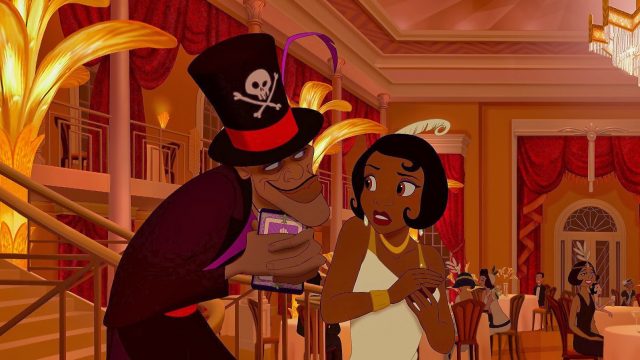This film is of course Disney’s first with a black “Disney Princess.” What’s perhaps less noticeable is that she is also Disney’s first princess to deal with institutionalized racism. It’s framed as being about class, I think, but it seems obvious to me that, when she is told that someone of her “upbringing” is unlikely to be able to afford payments on a building, that doesn’t mean that it’s because she’s working class and has been working as a waitress. It seems explicit to me that it’s about the fact that she’s black. Yes, she also has a white best friend, but they became friends because her mother worked for her friend’s father; there are actually both race and class issues there.
She is Tiana (Anika Noni Rose). When she was a child, her father (Terrence Howard) instilled in her the belief that they would open a restaurant. He worked himself to death to give it to her; she is now doing roughly the same thing. Her best friend is Charlotte La Bouff (Jennifer Cody), whose father (John Goodman) is a prominent man in New Orleans society. In this particular year, he is King of the Mardi Gras. He is also hosting a ball at which the generally foreign Prince Naveen (Bruno Campos) will be introduced to said society, with the strong implication that he’s going to marry Charlotte. Anyway, that’s what Charlotte wants.
What Naveen wants is to be a total libertine and gad about, but his parents have cut him off, so he’s got to marry a rich woman. Ready to take advantage of Naveen’s desperation is voodoo man Dr. Facilier (Keith David), who has Friends on the Other Side to whom he intends to feed Naveen’s soul, I guess? Anyway, it involves turning him into a frog. Naveen knows the drill—kissed by a princess, right? And he mistakes Tiana for the Princess of the Mardi Gras, being unfamiliar as he is with American racial issues, and since she isn’t a princess, when he kisses her, she becomes a frog as well. They end up in the bayou, seeking Old Voodoo Lady Mama Odie (Jenifer Lewis) to turn them back.
Naveen is consistent that Tiana needs to lighten up and have fun; Tiana is consistent that Naveen is a wastrel who needs to take life more seriously. And honestly, you can understand why Tiana works as hard as she does. She wants to be someone, to not be just a waitress anymore. Her mother worked as a seamstress all of Tiana’s life and has nothing to show for it. Her father, again, worked himself to death and had nothing to show for it. Tiana’s going to have something to show for it. Maybe she could take a little time for herself—her father did, after all—but what she wants is to have a happy life.
The movie is a bit of a musical tour of New Orleans, really; there’s some zydeco, some blues, some jazz, and so forth. There’s so much musical heritage to the city that it’s hard to know where to start; it’s been a city of music for a very long time. I don’t know as much about its antebellum cultural history, but I know it has some. I think that’s at least in part to do with being such a crossroads; everyone brought their culture, and when everyone brings their culture, there’s a lot of mixing and creation and so forth.
I feel as though this movie doesn’t get talked about much. It’s Disney’s last feature-length hand-drawn animation, which you’d think would be worth bringing up now and again, but people in general don’t. It’s the first black princess, which gets mentioned, but no one mentions that, one way or another, it would have Disney’s first explicit interracial relationship in an animated film. Sure, Naveen is sort of Vaguely Probably Mediterranean Ethnic, but by the racial standards of the ’20s, when it’s set, either his relationship with Charlotte would be interracial or his relationship with Tiana would be—and quite possibly both!
I like Tiana a lot. She’s not one to sit around and wish on a star, even though she expressly lives in a world with magic. Those Friends on the Other Side are really shaping the world, after all. But voodoo and hoodoo and things you haven’t tried are not a substitute for hard work and a little native skill at cooking. And, of course, Tiana’s dream realistically is to go off somewhere and work even harder, because running a good restaurant isn’t easy.
But to be honest, the thing I wish people talked about the most is the thing I’ve referenced repeatedly without saying its name—one of the best Disney villain songs in animated history. I have never entirely forgiven the Academy for nominating “Almost There” and “Down in New Orleans” instead. They’re not bad songs, but still. Dr. Facilier is an excellent, genuinely scary villain, and the implication of damnation is one of the strongest in the Disney pantheon outside Mr. Toad’s Wild Ride at Disneyland. What’s not to admire?

